Learn how to make a delicious yeast-free gluten-free sourdough bread using buckwheat and quinoa groats. What’s the best is that you won’t need no starter! You’ll only need 3 ingredients (not counting salt and water).
This gluten-free sourdough bread recipe is:
- plant-based
- oil-free
- flourless
- no knead
- yeast-free
- no starter
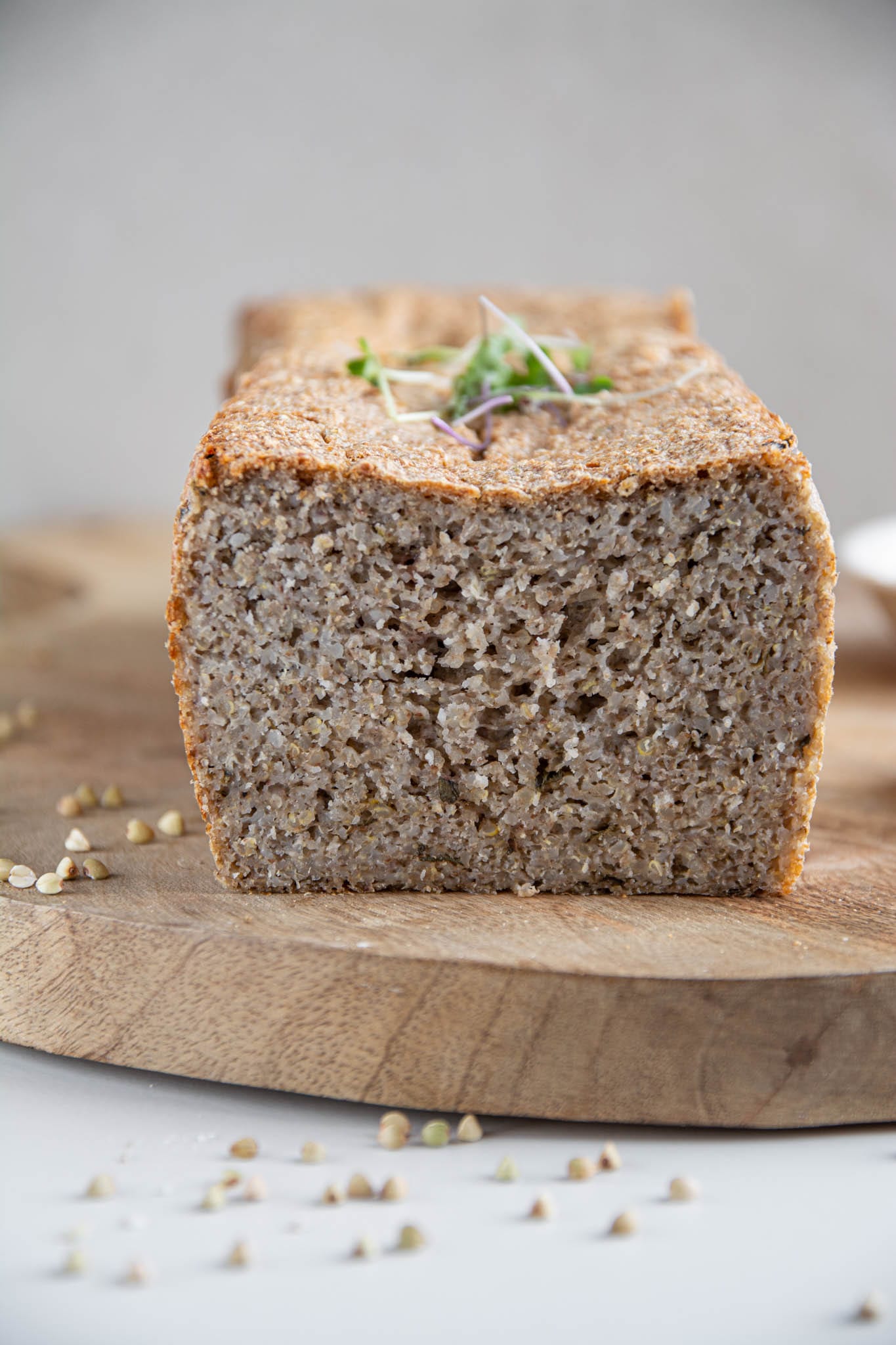
I find it fascinating that you won’t need a dutch oven or any gluten-free sourdough starter and therefore don’t need to feed your starter either.
Table of contents
How to Make Gluten-Free Sourdough Bread
The Ingredients
When it comes to gluten-free baking recipes, then usually some sort of gluten-free flour is utilised. For example, brown rice flour, millet flour, or sorghum flour. In addition, very often binders come into play as well, e.g. xantham gum or psyllium husks.
My recipe aims to differ. Instead of flour I use whole raw buckwheat and quinoa groats that will be soaked and blended into batter.
Himalayan salt is the second most important ingredient. Without it, the bread would simply taste blunt.
Finally, I’m adding some dried oregano for extra flavour. And that’s it!
The Equipment
Fortunately, you do not need anything fancy and expensive to make this delicious gluten-free sourdough bread. Here’s the short list:
- A large ceramic or glass bowl for soaking buckwheat and quinoa groats as well as for fermenting the bread batter.
- A large sieve to rinse and drain the grain groats.
- A kitchen or tea towel or a plastic bag/cling wrap to cover the bowl with while the dough ferments.
- A spatula or a big spoon to mix the batter.
- A ceramic or glass bread pan for baking the bread.
- Parchment paper to line your bread pan with when baking the bread.
The Process
It takes minimally 10 hours for the bread to be ready, but the active prep time is only about 15 minutes.
Soaking
You start by pouring raw buckwheat and quinoa groats into a large bowl and soak them in water for at least 4-6 hours. However, overnight is equally fine.
After soaking, take a large sieve and thoroughly rinse the groats under running water. You’ll notice that the water is quite slimy. Not to worry though as it’s normal. In case you’ve soaked raw buckwheat before, this will not be a surprise to you at all.
Now, place the sieve in the mount of a large bowl to let it drain completely. It may take a few minutes.
It’s worth mentioning that soaking reduces the phytates (anti-nutrients) in grains so that the minerals become better absorbed and the grains easier to digest. If you’re interested to learn more, go to Science-Backed Food Combining Rules.
Sprouting (optional)
Next, you may go the extra mile and sprout the grains before moving forward with the recipe. However, this is absolutely not mandatory. You may move on to the next step if you’re in a hurry or feel that this is not necessary.
Sprouting has been shown to reduce phytates even further and to increase the bioavailability of nutrients.
In order to sprout the soaked buckwheat and quinoa simply leave them in the sieve in the mouth of a large bowl and cover with clean kitchen cloth. 12 hours should be enough for the buckwheat to have tiny visible sprouts. In other words, you’ll see that it’s about to sprout. Quinoa will be fully sprouted by the same time.
Make sure to rinse the groats with cold water several times during those 12 hours. Otherwise, you might have mould developing. To be absolutely certain, you may divide the groats between two large sieves. This way you have more air flowing between them. Learn more from How to Sprout Buckwheat.
Blending and Fermentation
Take your soaked (or sprouted) groats and transfer them into a large glass or ceramic bowl. Metal bowl will interfere with fermentation process.
Next, add filtered water and process with either regular blender or an immersion blender. Unless you have a high-speed super-power blender like Vitamix, I’d suggest choosing immersion blender as your tool. It’s because I’ve found it easier to handle – my regular blender struggles with processing such a thick mass and it’s therefore difficult to get a homogenous batter.
In case you’re using Vitamix, be careful not to over-blend the mixture as you might end up with a bread that’s too dense.
After blending, cover the bowl with a plastic or a clean kitchen cloth and place it into a warm oven. I turn my oven on to 30-35°C (86-95°F). In case your oven does not have this function, try with leaving the lights on. The lamps should produce some warmth on their own. Alternatively, leave the bowl in the sun or onto a radiator.
After 4.5-5 hours your batter should have risen quite a lot and you should see bubbles throughout the batter. Check the video for visuals.
In case you can’t use your oven, it’s not heating season and there’s no sun either, the fermentation will simply take longer. Be ready for about 14-hour period depending on the room temperature.
Be careful not to ferment the batter for too long though. If it smells foul or turns into a funny colour, I’d suggest you throw it out. You’ll learn what is the maximum time for fermentation in your kitchen by trial and error. However, in the beginning I suggest you follow the timeframe given in this recipe and observe the batter from time to time to catch the state you see in my video.
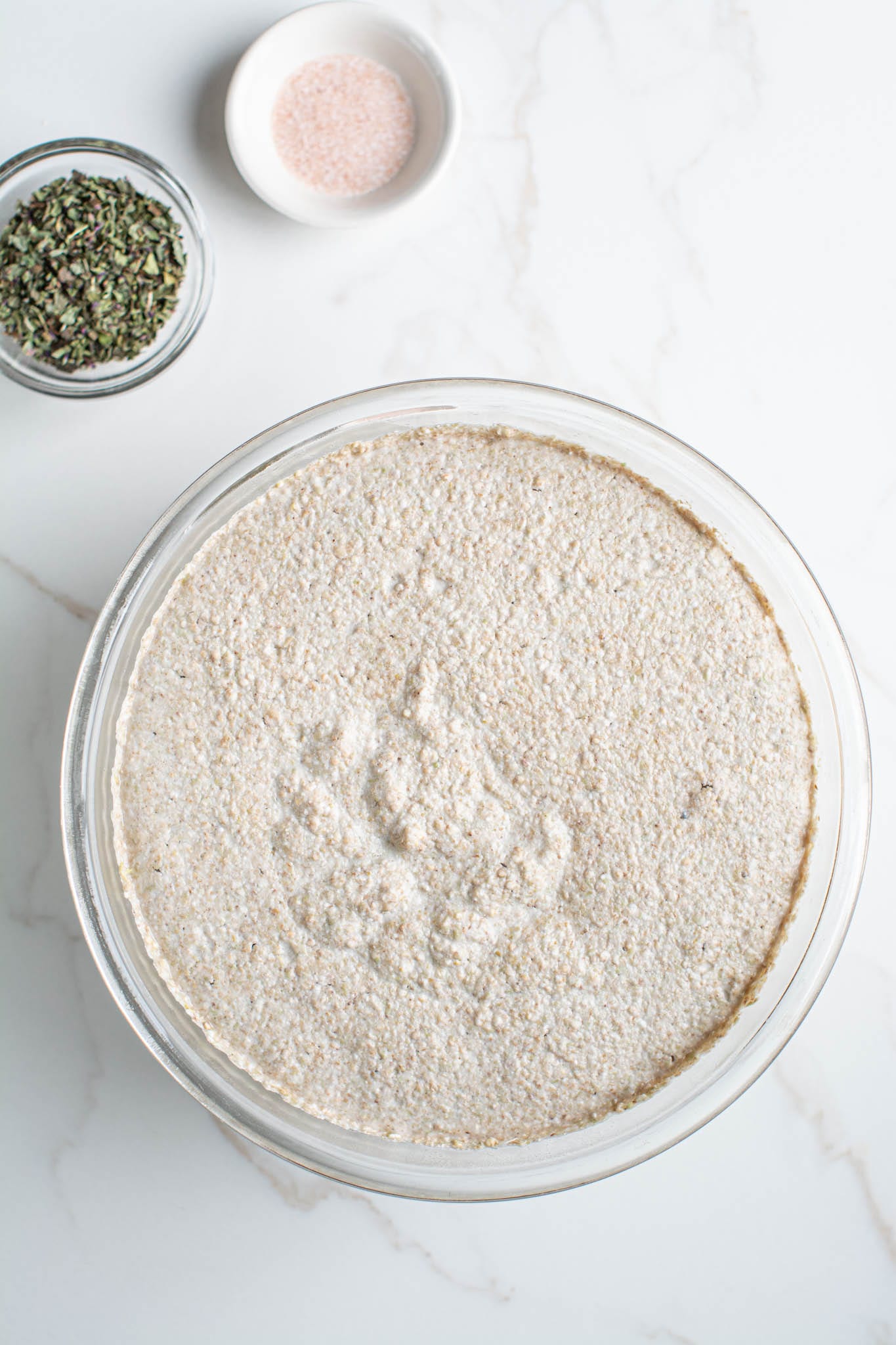
Mixing and Baking
The next step after fermentation is to gently fold in Himalayan salt and oregano. Try to avoid vigorous movements not to mess with the fluffiness of the batter.
You may add other spices and herbs. For example, thyme, rosemary or even cinnamon and cardamom. Seeds like sunflower seeds, hemp seeds and pumpkin seeds would also be a great addition.
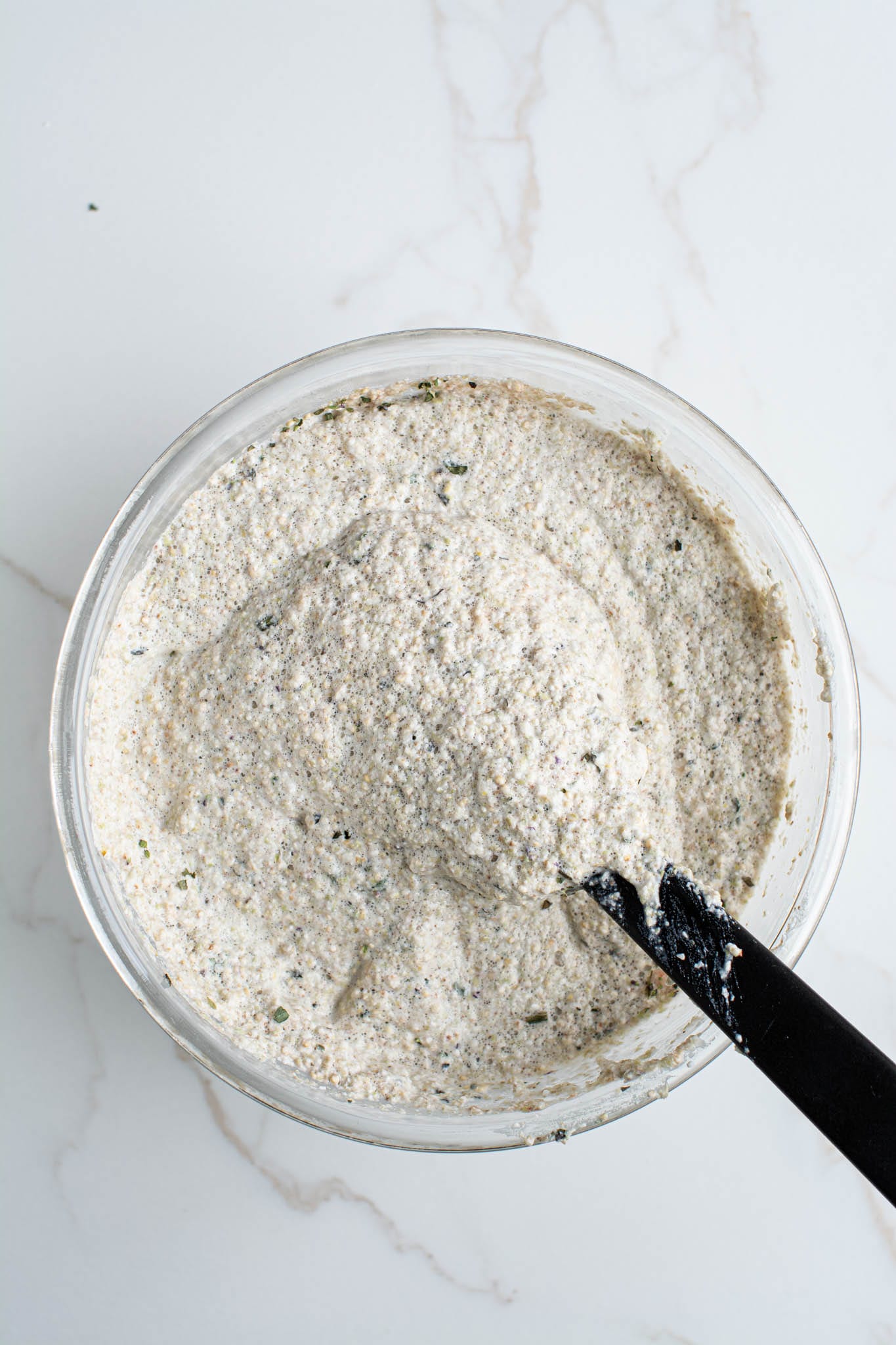
Now, pour the batter into bread tin lined with parchment paper. I used my handmade ceramic loaf (27x9cm, 10.6×3.5inch) which is not standard. I’d say you can go for 25x9cm (9.8×3.5inch) bread tin.
Unlike my fermented buckwheat bread, I find that the quinoa version does not need any final proofing. It’s because the batter doesn’t deflate as much during the mixing process.
So, after pouring the batter into bread tin, you can put it into oven straight away. Now, pay attention – put the bread into cold oven, close the door and turn the heat onto 175°C (350°F). Make sure NOT to use the fast heat function and NOT to have the grill on. Set the timer to 1 hour and 15 minutes and wait.
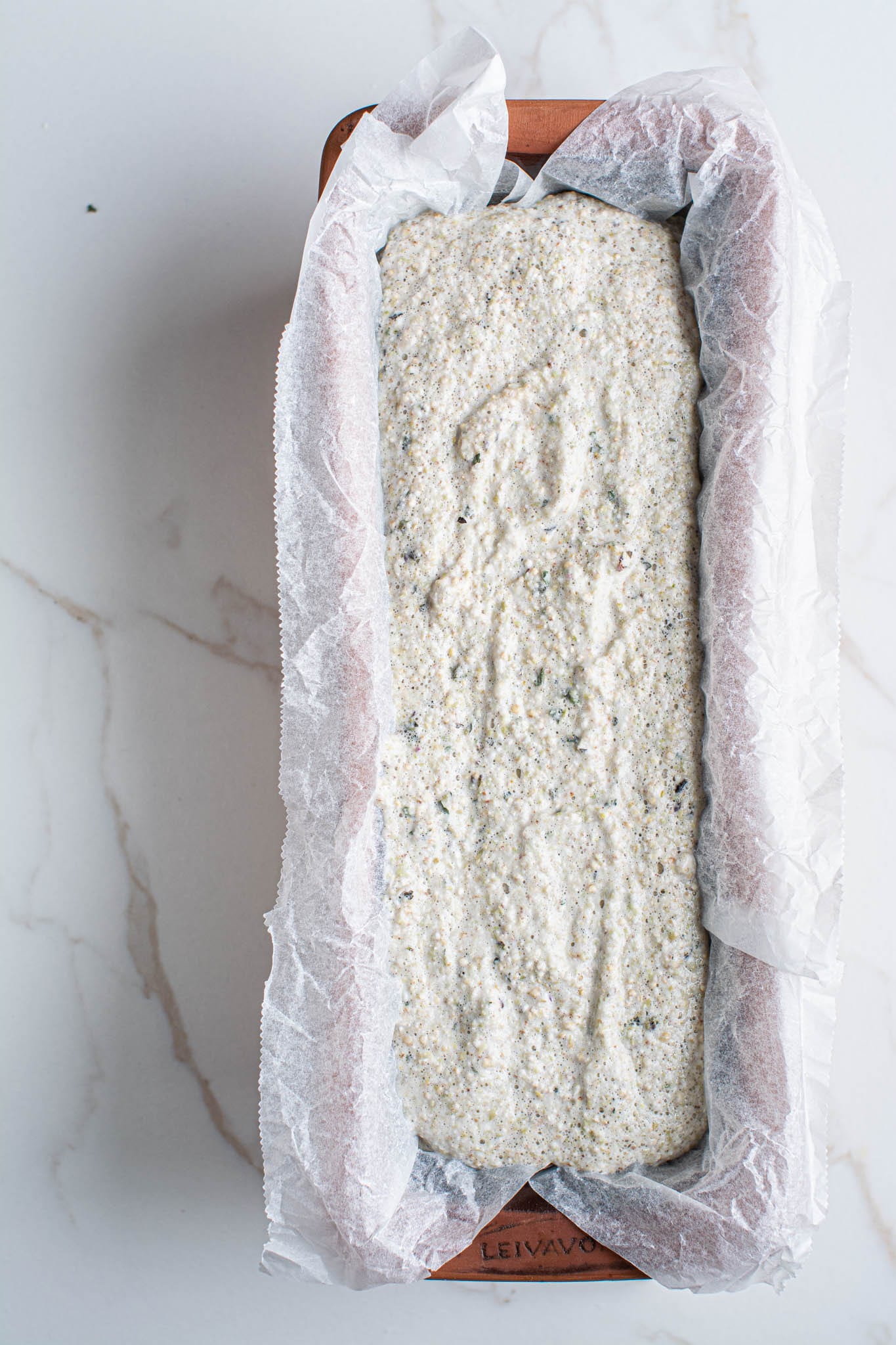
When the time is up, open the oven door and tap onto the crust of the bread with your finger. The bread is ready if it sounds hollow.
Let the bread cool completely before slicing into it. This takes about an hour. Should you be extra impatient, 30 minutes is the minimum you ought to be able to wait.
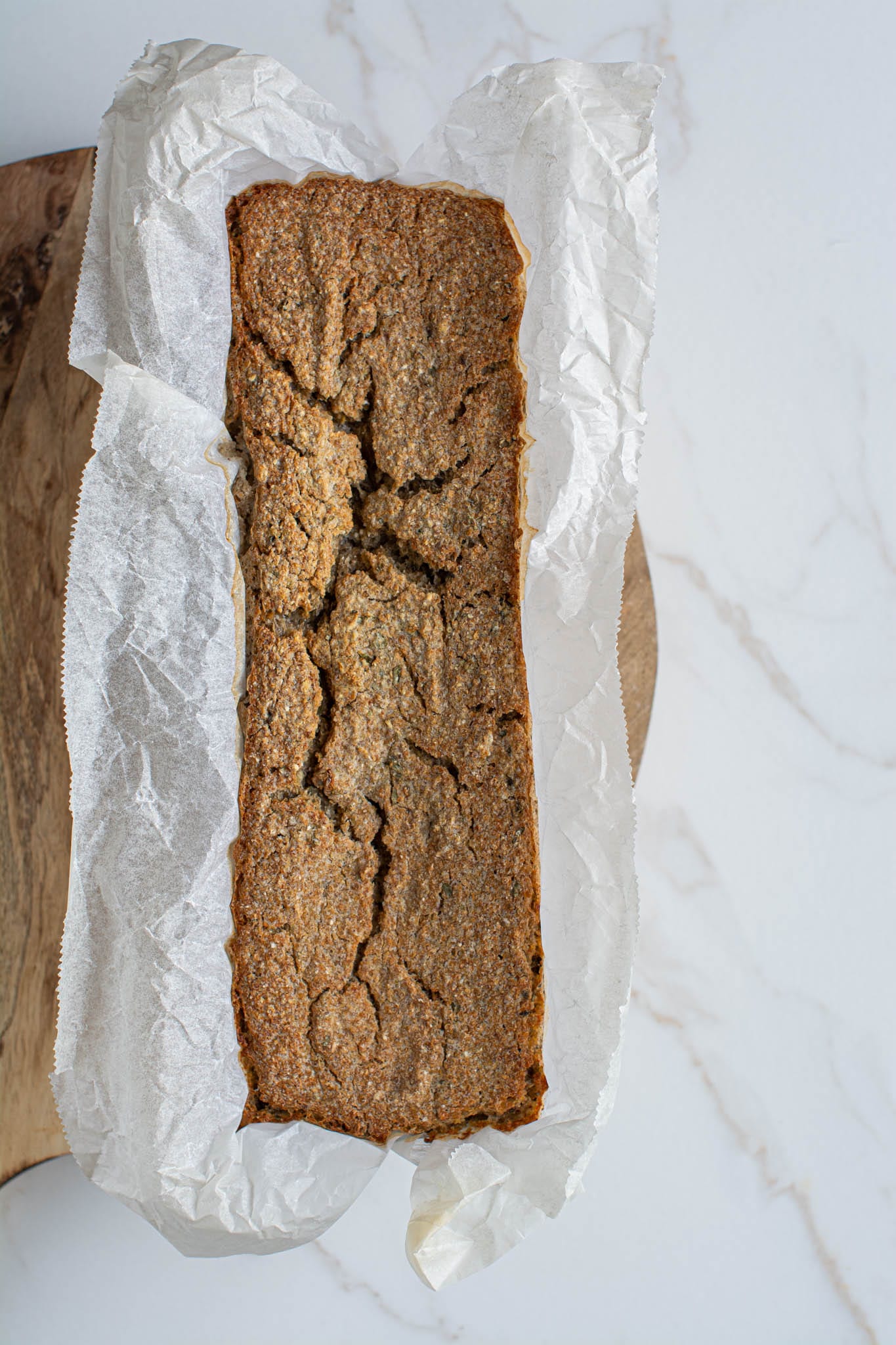
How to Store This Gluten-Free Sourdough Bread
When the bread is cooled wrap it into a clean kitchen towel and stick it into a plastic bag to prevent losing too much moisture. It keeps well on countertop for 2 days.
For longer keeping slice the bread up as soon as it’s cooled and store the individual slices in freezer. Heat them up in a microwave (for soft result) or in oven or toaster (for crunchy slices).
In order to toast the frozen sourdough bread slices in the oven, place them onto the rack (not on a baking sheet), set the oven to fast heat function (175°C, 350°F is enough) and timer to 10 minutes. When the time’s up, you’ll have fresh and crispy bread ready to enjoy.
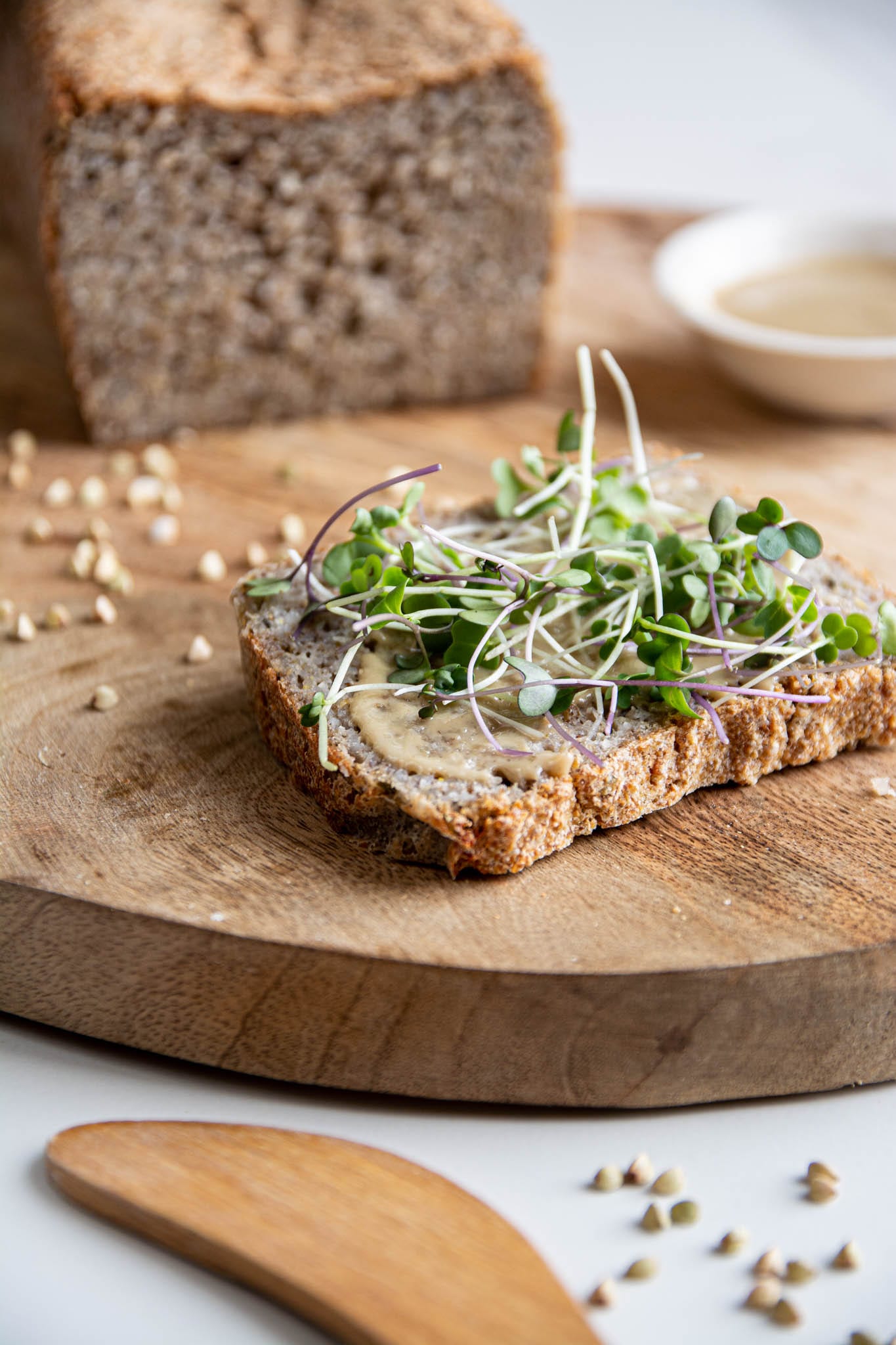
Ideas for Serving Buckwheat-Quinoa Sourdough Bread
In my experience, freshly baked sourdough bread is so damn good that you don’t even need anything to accompany it with. However, should you disagree, here are some ideas:
Spread the bread with avocado, nut or seed butter (tahini, almond butter, peanut butter, cashew butter), homemade applesauce, hummus, homemade vegan mayonnaise, or even sweet buckwheat ricotta.
In addition, top it with red cabbage coleslaw, sauerkraut, kimchi, tofu or tempeh slices, or vegan egg salad.
You can use a few or many of the options mentioned above and build an epic healthy vegan sandwich. On the photo below I used avocado spread, fermented tofu, kimchi and broccoli sprouts for delicious toasts.
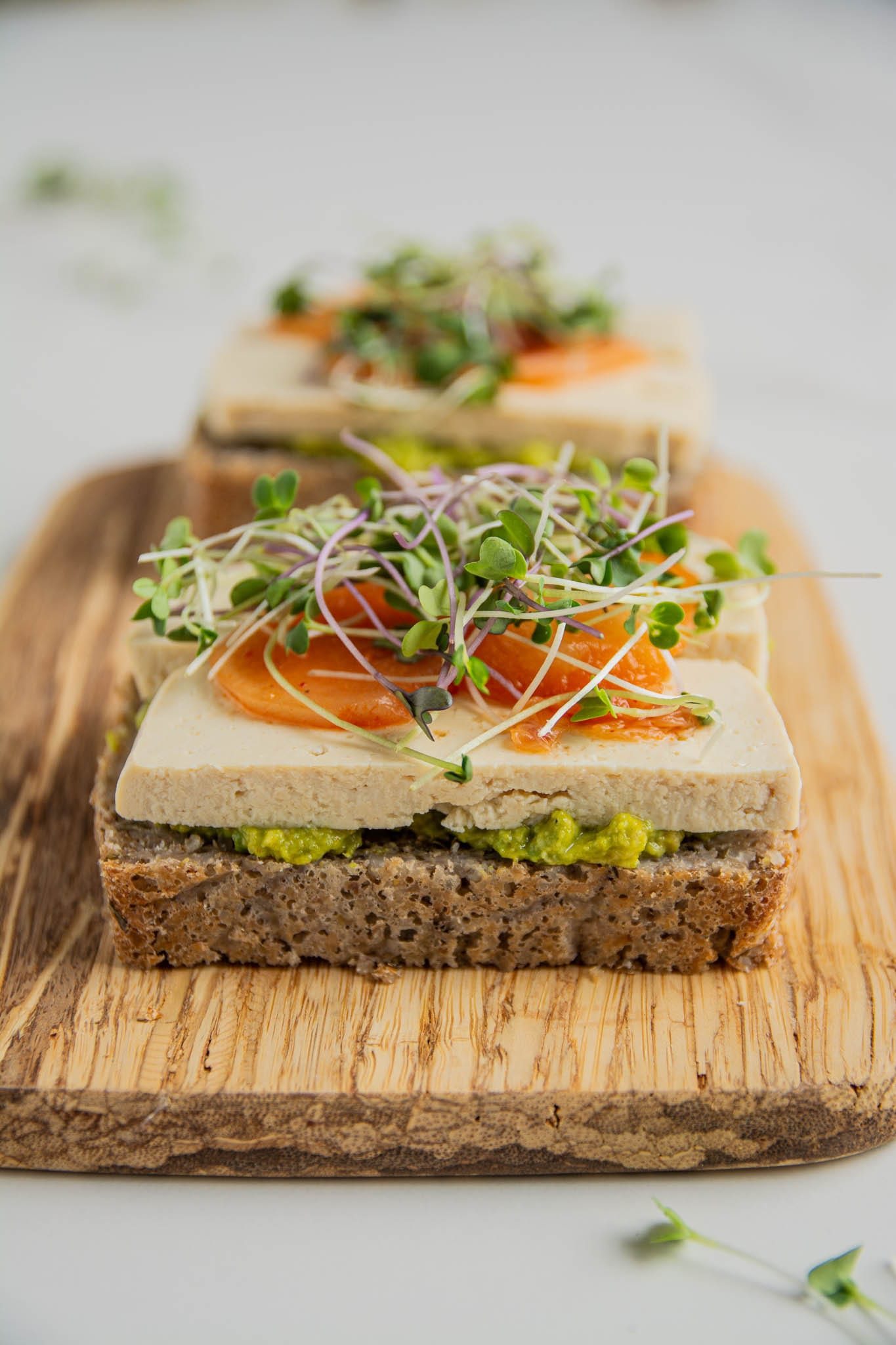
Given your interest in sourdough bread, you might also like to check out the following recipes:
- No-Starter Fermented Buckwheat Bread
- Basic Buckwheat Sourdough Recipe and How to Use It
- Chocolaty Buckwheat Sourdough Pancakes
- Buckwheat Sourdough Pancakes
- Whole Spelt Sourdough Bread
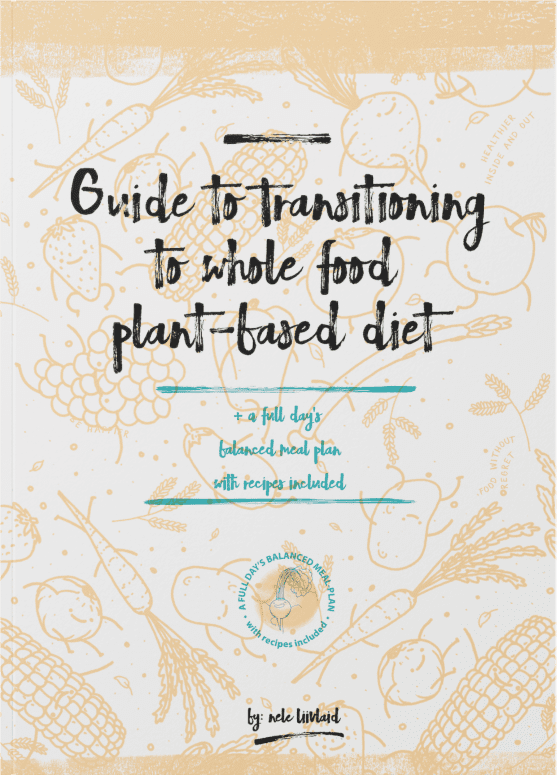
Download my FREE Guide to Plant-Based Diet
Including a full day’s meal plan!
Learn the basics, prepare your kitchen and pantry, compile a balanced meal plan, handle challenges with family and friends, learn the tricks of dining out as well as travelling.
Learn the secrets of weight loss, better health and happiness!
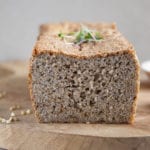
How to Make Gluten-Free Sourdough Bread [Video]
- Total Time: 10 hours
- Yield: 22 slices 1x
- Diet: Gluten Free
Description
Learn how to make a delicious yeast-free gluten-free sourdough bread using buckwheat and quinoa groats. What’s the best is that you won’t need no starter! You’ll only need 3 ingredients (not counting salt and water).
Soaking time: 4-6 hours
Fermentation time: 4.5-5 hours
Ingredients
- 325g (11.5oz) raw buckwheat groats
- 100g (3.5oz) white quinoa groats
- 290g (10.2oz) filtered water
- ½ tsp. Himalayan salt
- 2 tbsps. dried oregano
Instructions
Soaking
- In a large bowl, soak raw buckwheat and quinoa groats for at least 4-6 hours. However, overnight is equally fine.
- After soaking, take a large sieve and thoroughly rinse the groats under running water. You’ll notice that the water is quite slimy. Not to worry though as it’s normal.
- Now, place the sieve in the mount of a large bowl to let it drain completely. It may take a few minutes.
Blending and Fermentation
- Take your soaked groats and transfer them into a large glass or ceramic bowl. Metal bowl will interfere with fermentation process.
- Next, add filtered water and process with either regular blender or an immersion blender. Unless you have a high-speed super-power blender like Vitamix, I’d suggest choosing immersion blender as your tool. It’s because I’ve found it easier to handle. In case you’re using Vitamix, be careful not to over-blend the mixture as you might end up with a bread that’s too dense.
- After blending, cover the bowl with a plastic or a clean kitchen cloth and place it into a warm oven. I turn my oven on to 30-35°C (86-95°F). In case your oven does not have this function, try with leaving the lights on. The lamps should produce some warmth on their own. Alternatively, leave the bowl in the sun or onto a radiator.
- After 4.5-5 hours your batter should have risen quite a lot and you should see bubbles throughout the batter. Check the video for visuals. In case you can’t use your oven, it’s not heating season and there’s no sun either, the fermentation will simply take longer. Be ready for about a 14-hour period depending on the room temperature.
- Be careful not to ferment the batter for too long though. If it smells foul or turns into a funny colour, I’d suggest you throw it out. You’ll learn what is the maximum time for fermentation in your kitchen by trial and error. However, in the beginning I suggest you follow the timeframe given in this recipe and observe the batter from time to time to catch the state you see in my video.
Mixing and Baking
- Now, gently fold in Himalayan salt and oregano. Try to avoid vigorous movements not to mess with the fluffiness of the batter.
- Next, pour the batter into bread tin lined with parchment paper. I used my handmade ceramic loaf (27x9cm, 10.6×3.5inch) which is not standard. I’d say you can go for 25x9cm (9.8×3.5inch) bread tin.
- Put the bread into cold oven, close the door and turn the heat onto 175°C (350°F). Make sure NOT to use the fast heat function and NOT to have the grill on. Set the timer to 1 hour and 15 minutes and wait.
- When the time is up, open the oven door and tap onto the crust of the bread with your finger. The bread is ready if it sounds hollow.
- Let the bread cool completely before slicing into it. This takes about an hour. Should you be extra impatient, 30 minutes is the minimum you ought to be able to wait.
Notes
You may sprout buckwheat and quinoa groats before blending the batter. Check instructions from blog post (above the recipe card).
- Prep Time: 15 minutes
- Cook Time: 1 hour 15 minutes
- Category: Bread
- Method: Oven
Nutrition
- Serving Size: 1/22 of the recipe
- Calories: 69 kcal
- Sodium: 51.7mg
- Fat: 0.8g
- Saturated Fat: 0.1g
- Carbohydrates: 11.6g
- Fiber: 2g
- Protein: 2.8g
Disclosure: this post contains affiliate links. As an Amazon Associate I earn from qualifying purchases. For every purchase made from the links in this post, you’ll be able to support my work. So you can look after your health, and contribute to my mission at the same time. Thank you!
You’re welcome to PIN the below image!
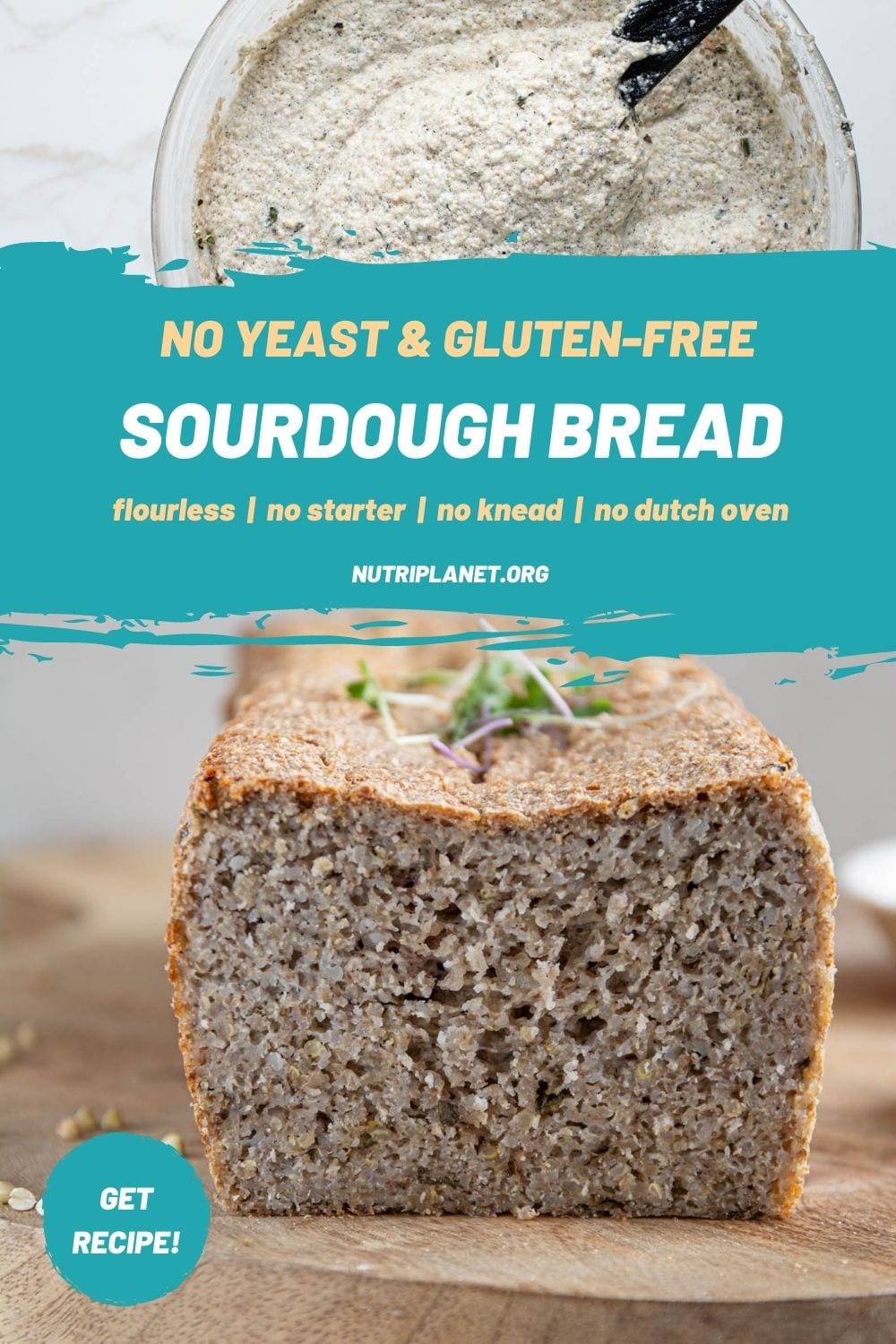

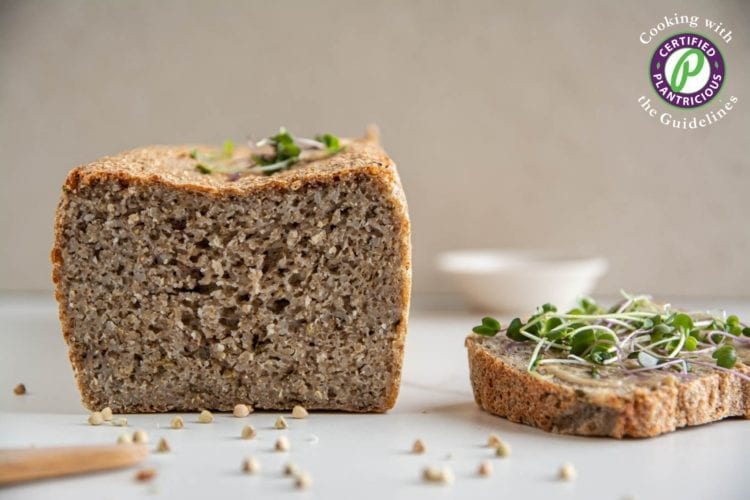









Thank you Nele. We love your sorghum muffins too. I will try some of your ideas, as flatbread and tortillas.
I’m so happy to hear that! Enjoy! 🤗